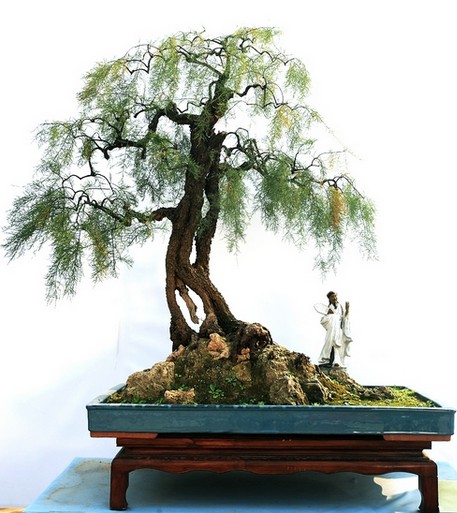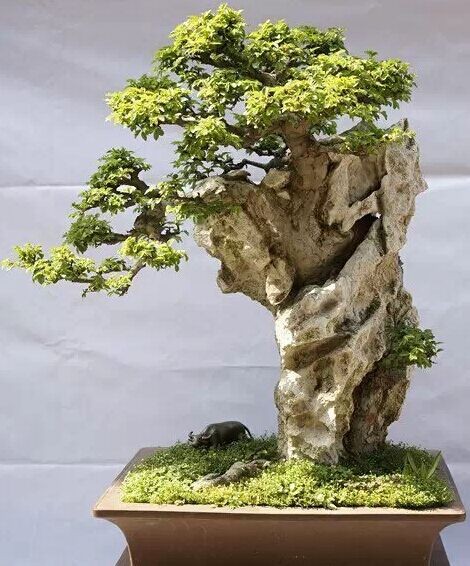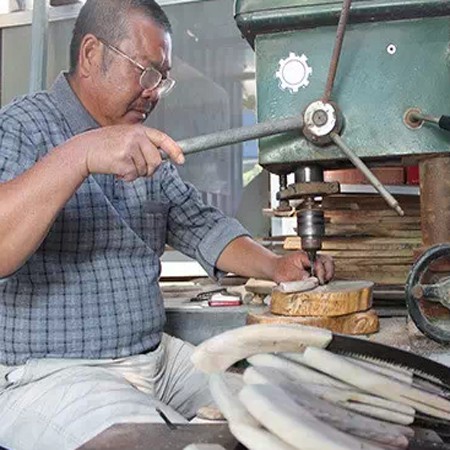Production and Collection of Tamarix trunks with Stone Bonsai
The production of Tamarix trunks with stone bonsai is basically the same as that of other trunk bonsai. Tang Qingan, master of bonsai art in Zhongzhou and provincial bonsai art master, said that attention should be paid to stone selection, basin selection, seedling selection, modeling and so on in the production of Tamarix trunks with stone bonsai.

In the selection of stones, we should choose those stones that are hard. Soft stones are easy to be cracked by tree trunks, and soft stones such as absorbent stone and straw stone should not be selected. The hard stone is the first choice for Yingde quartz stone from Guangdong, followed by Anhui Lingbi stone, Shandong Feixian stone, Henan Taihang stone and so on. In shape, the stone with the characteristics of thin height, mountain shape and adventure is the best. If the stone itself has a better ornamental, in combination with the tree trunk, the effect will be better. Shallow bonsai basin, glaze basin, purple sand basin and porcelain basin can be used to make Tamarix trunks with stone bonsai. But no matter which basin you choose, there must be a drain hole. Collectors can also choose their favorite basin punching production. The size of the basin and stone should be in a moderate proportion to avoid the large stone or the small stone.
After selecting the stone and basin, it is necessary to observe and select the best viewing surface of the stone, as well as the best position of the stone in the basin. When the stone and basin are bonded and fixed, the stone and basin should be washed clean and built with cement. Tang Qingan said that when bonding stone and basin, collectors should pay special attention to keeping the bonding surface below the basin surface, and do not make cement and other sundries expose the basin surface. After the building is finished, collectors should carry out sprinkling maintenance every day, and if it is in winter, they should also do a good job of anti-freezing. In general, four or five days later, collectors can begin to make attached stones.
The first step in stone attachment is slotting. On the viewing surface, the collector should find out the best branch point of the sapling on the stone and the best burying position of the lower part of the stone, and then design the route between the two points. The line should not be too straight, it is better to bend a little, and it is the first choice to be able to wind around the stone. When slotting, we should also refer to the thickness of the saplings, and the grooves had better accommodate the saplings.
To make saplings with stone trunks, choose annual saplings with a trunk diameter of no more than 1 cm to facilitate production. When attaching stones, the saplings should be embedded in the grooves and fixed with wire in a bottom-up order. At this point, the production of Tamarix trunks with stone bonsai has been initially completed. Next, the production of bonsai trees is the real embodiment of bonsai art. The previous part is more of a production technique. In this link, collectors should skillfully produce different styles of bonsai, such as cliff type, oblique dry type, qu dry type, natural type, imitation pine type and so on. Collectors must have certain knowledge and artistic attainments in bonsai production.
Time: 2019-06-04 Click:
- Prev

Sharing of experience in making stone bonsai
Holding stone bonsai is composed of rough roots, sandwiched with rocks, and necessary election to embellish some bonsai accessories. It has the potential to stand erect on the peak, giving people the feeling of perseverance, continuous progress and endless life.
- Next

Reluctant to give up: the discovery of natural stone bonsai
In a cabin in the bonsai garden, a dark-skinned old man is using a saw knife to make a special instrument for bonsai. The old man, named Chen Changchun, used to be a worker of Xiapu County Garden Bureau. After retirement, he focused on bonsai art and was also one of the operators of bonsai garden. Guo Xuhui and Lao Zheng told reporters
Related
- Fuxing push coffee new agricultural production and marketing class: lack of small-scale processing plants
- Jujube rice field leisure farm deep ploughing Yilan for five years to create a space for organic food and play
- Nongyu Farm-A trial of organic papaya for brave women with advanced technology
- Four points for attention in the prevention and control of diseases and insect pests of edible fungi
- How to add nutrient solution to Edible Fungi
- Is there any good way to control edible fungus mites?
- Open Inoculation Technology of Edible Fungi
- Is there any clever way to use fertilizer for edible fungus in winter?
- What agents are used to kill the pathogens of edible fungi in the mushroom shed?
- Rapid drying of Edible Fungi

